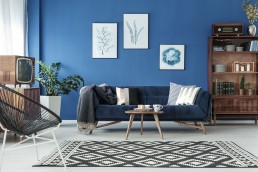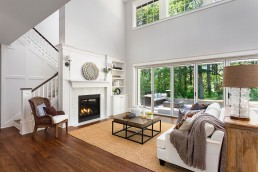We all know style when we see it – but how many of us are confident about creating it in our homes? When redecorating a room, there’s always a temptation to choose furniture that ‘matches’ so we can be sure to avoid expensive style blunders – but this strategy often misses the mark when it comes to creating authentic interiors with depth and interest.
When it comes to creating the kind of interiors we all lust after, layering is key. Whether you’ve lived in your home for 5 years or 5 weeks, the secret of timeless style is to build up layers of interest to create the impression of an interior that has evolved over time, with new pieces of furniture, soft furnishings and accessories added little by little.
Of course, our nomadic modern lifestyles mean most of us will start decorating a new home from scratch many times in our lifetime – so how can we create that soft, carefully curated look without spending years doing it?
Well, here at DINE Living, we believe that wood has a key part to play.
Once regarded as a style faux pas, combining different wood finishes is now an interior designer’s go-to trick for creating a sense of permanence in a room. Blending different tones and styles avoids that ‘matchy matchy’ high street look while still producing a cohesive, pulled-together feel. But before you go wild in the aisles choosing different wood finishes, be warned – there are some rules to follow if you want your mismatched scheme to work!

Rule #1
Make sure every piece has a pair
Rather than choosing a different tone for every wooden element in a space, work in pairs. For each large piece of wooden furniture, try to echo the same shade in a smaller accent – perhaps match the wood from your dining table to a shelf or frame on the wall, or the legs of a side table, and then choose a different wood for your dining chairs, but pair them with a sideboard or occasional chair in the same wood. This creates a curated look that’s relaxed but still refined.

Rule #2
Tone it in
You don’t have to match woods and grains, but choosing tones that work together is key to successfully blending different timbers together. Starting with the most dominant wooden element in the room (often the floor!), establish whether it has cool or warm tones, and choose other wooden elements that have similar tones – but don’t forget, ‘darker’ doesn’t always mean ‘warmer’. Our dark oak and black timbers look fantastic in both warm and cool settings, while the honeyed tones of our natural oak mean it combines effortlessly with pale woods as well as warmer tones like cherry or mahogany.

Rule #3
Aim for consistency of style
We believe that when it comes to interiors, rules are made to be broken – but too much rule-breaking can leave your room feeling jumbled and unsettling. If you’re mixing wood finishes, it’s best to maintain some consistency of style, so if you love the mid-century look, stick to clean lines and soft curves, and if you’re going for a period feel, choose complementary pieces that share a sense of elegance even if they’re not made from the same wood.

Rule #4
Never underestimate the power of accessories
You’ve created a relationship between your mismatched furniture using shape and tone – now it’s time to cement that relationship with accessories! It’s amazing how a few well-chosen pieces can pull a whole room together for a really ‘designed’ look. Introducing an accent colour, for example, can make a huge difference, and it’s easy to do with the addition of cushions, throws and even decorative objects. Likewise, the boundaries between two wood finishes can be blurred with clever accessorizing – the contrast between a light wood floor and a dark wood table can be blurred by adding a rug, or you can even select furniture with a burred or inlaid finish, displaying different wood tones within a single piece to pull the whole look together.